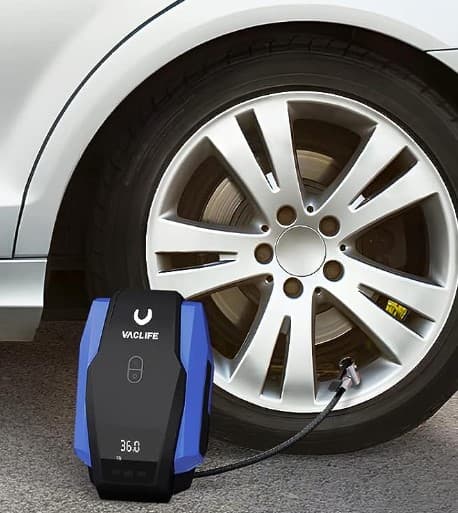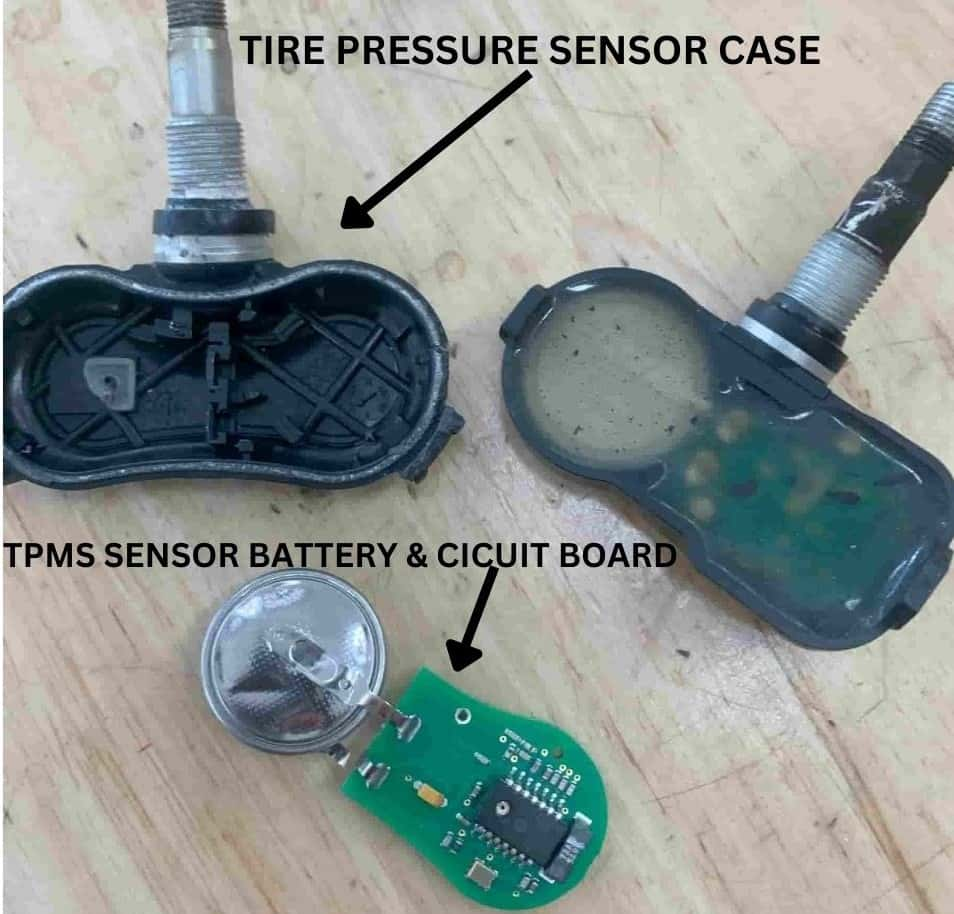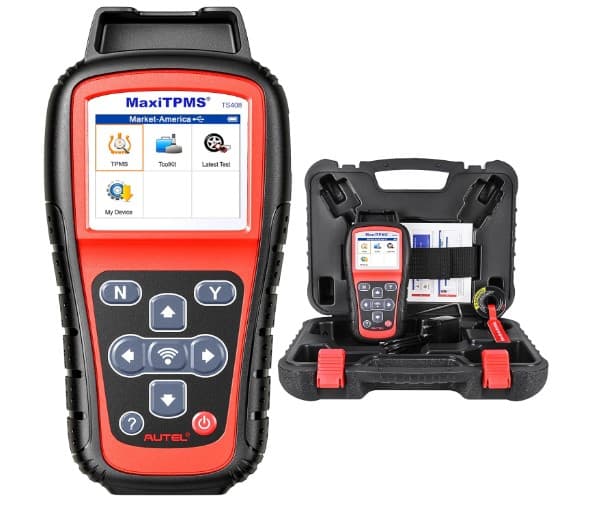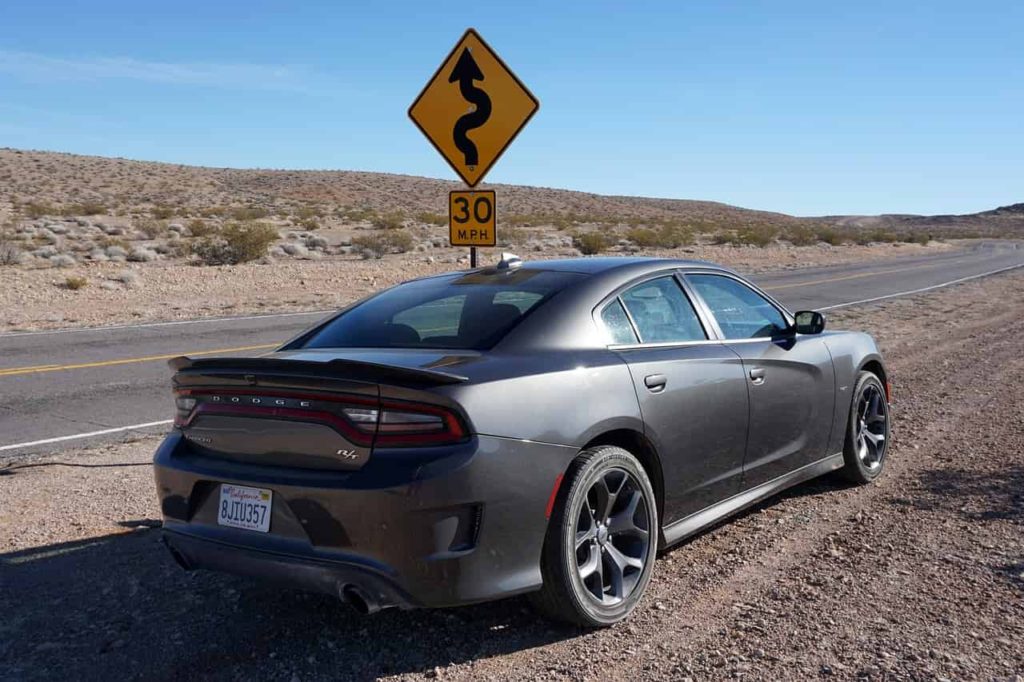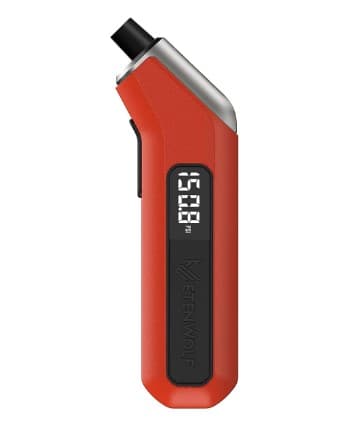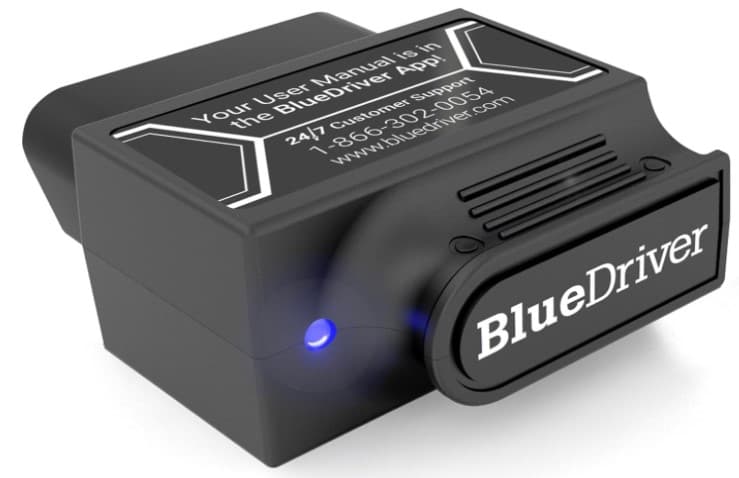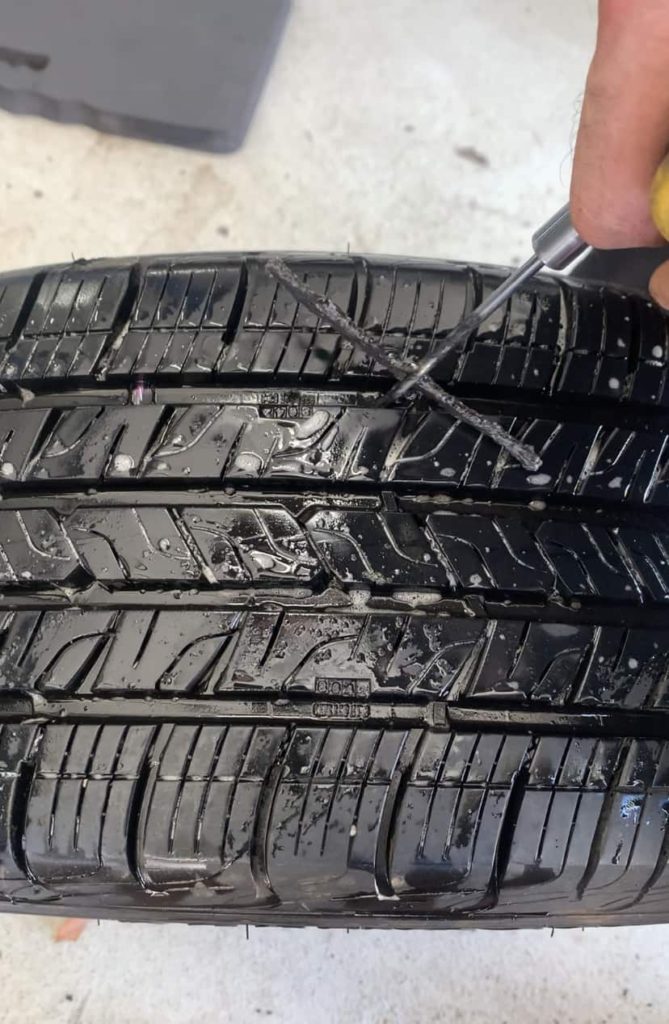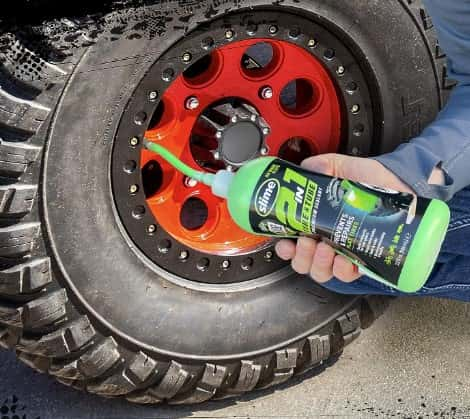What is the Dodge Charger TPMS?
The Dodge Charger tire pressure monitoring system exists to keep the driver and vehicle as safe as possible. When a tire pressure alert is triggered the system detects an issue within one or more of its tires. The tire pressure system is made up of tire pressure sensors, the Dodge Charger ECM, and a TPMS receiver module. This is how they work:
How Does the Dodge Charger Tire Pressure System Work?
Sensors within Dodge Charger Tires: Each tire of the Dodge Charger houses a sensor that perpetually gauges the tire’s air pressure and temperature. While it remains concealed unless the tire is removed, its placement is at the foundation of each valve stem. This sensor consists of a circuit board connected to a battery and an antenna, all enclosed in a protective plastic housing.
Real-time Data Transmission: These sensors utilize radio waves to convey their instantaneous data wirelessly to the car’s computing system. They function predominantly on the 315 Mhz or 433 Mhz frequency channels.
Interplay with the TPMS Receiver Module: Functioning as a link, this particular module (small circuit board) captures the data from the sensors, processing it further for the Dodge Charger’s principal computer system.
Dodge Charger Computer (ECM): Upon receiving the data, the ECM breaks it down to determine whether the tire’s pressure remains within the set standards.
Alert Mechanism for Low Pressure: In case of suboptimal tire pressure, the ECM not only illuminates a warning light on the console but also sounds a chime. The Dodge Charger’s screen further assists the driver by pinpointing the specific tire and suggesting the correct inflation level, showing a “Tire Low Inflate to XX PSI” advisory.
Dodge Charger TPMS’s Self-Diagnostic Capacity: The TPMS of the Dodge Charger boasts a self-assessment feature. If an issue prevents a tire sensor from communicating with the ECM, a blinking tire pressure icon manifests, accompanied by a “SERVICE TPM SYSTEM” notification on the display.
Steps to Reset the Dodge Charger Tire Light
Park the Dodge Charger on level terrain.
Adjust all four tires to their recommended cold inflation pressures.
Drive in the Dodge Charger for 20 minutes at speeds exceeding 15 Mph (24 km/h).
How to Deactivate the Dodge Charger TPMS
To disable the Dodge Charger TPMS, fit it with wheels devoid of tire pressure sensors. Here’s the method:
Install four wheels that are not equipped with tire pressure sensors.
Drive in the Dodge Charger, maintaining a speed above 15 Mph for at least 20 minutes.
You’ll hear a chime from the tire monitoring system, and the TPMS light will blink for about 75 seconds and then stay illuminated.
An alert “SERVICE TPM SYSTEM” will pop up, and tire pressure measurements will be replaced by dashes (~).
Power down the engine.
Start the engine again.
While the “SERVICE TPM SYSTEM” notification will disappear, the dashes (~) will continue to represent the absence of pressure readings.
How to Reactivate the Dodge Charger TPMS
Re-Mount the original Dodge Charger wheels and tires with the tire pressure sensors.
Drive in the Dodge Charger for at least 20 minutes, ensuring speeds are in excess of 15 Mph.
You’ll be alerted by a chime from the tire pressure system, and the TPMS light will flash before eventually shutting off.
Power the engine down and then restart it.
After restarting the engine and driving the Charger, the tire pressures will be displayed instead of the dashes (~).
2022 Dodge Charger Tire Pressures
TIRE SIZE | FRONT PSI | REAR PSI |
215/65R17 | 32 | 32 |
235/55R19 | 32 | 32 |
245/45R20 | 32 | 32 |
What Triggers the Low Tire Pressure Warning in a Dodge Charger?
Tires below the recommended air pressure levels
Tires inflated beyond the suggested limit
Tires that are deflating
Lack of tire monitoring sensors in the wheels (like when driving with the spare tire)
Battery issues in the TPMS sensor
Malfunctions in the TPMS receiving system or onboard computer
External electronic disruptions or similar vehicles causing radio frequency interference
Changes in weather and/or altitude
Excessive cargo weight or passengers in the Charger
Fitting of chains to the tires
Dark window tints
Driving over potholes, sharp objects, or curbs
Tires with external damage, abrasions, dry-rot, or bubbles
Batteries in Dodge Charger's Tire Pressure Sensors
Every Dodge Charger wheel houses a tire pressure sensor, consisting of a tiny circuit board, an antenna, and a silver-oxide battery. As the battery is directly tied to the circuit board, individual battery replacement or recharging isn’t an option. Once the sensor’s power is exhausted, you’ll need to change out the entire pressure unit. On average, a Dodge Charger’s tire pressure sensors have a lifespan ranging from 5 to 10 years or approximately 100,000 miles traveled.
Troubleshooting the Dodge Charger's TPMS Light
At times, despite following the TPMS reset instructions, the tire pressure light on the Dodge Charger refuses to switch off. The process to identify the underlying issue with the low tire pressure light often involves a sequence trying different solutions. Should you face this predicament, explore one or multiple of the suggested solutions for the tire pressure light:
SOLUTION 1: IS THE TIRE DEFLATING OR LOSING PRESSURE?
When you notice the low tire pressure alert, the initial response should be to identify any tire possibly deflating because of an air leak. If one tire out of the four is underinflated, a leak is often the reason. To confirm, execute the steps below:
Park the Dodge Charger on level terrain and conduct a visual examination of each tire for potential irregularities.
Figure out the suggested tire pressure and inflate the affected tire, making certain it aligns with the specified OEM pressure.
Take a 20-minute drive, keeping your speed over 15 Mph, after which the alert should deactivate.
⏩CONCLUSION: In the event the alert gets triggered again, either immediately following the drive or in subsequent days, with the same tire being the issue, this tire is likely leaking air. To ascertain the leak’s exact position, consult SOLUTION 6.
SOLUTION 2: HOW TO RESET THE ECM IN A DODGE CHARGER
Upon activation of the low tire pressure alert, the Dodge Charger’s onboard computer logs a diagnostic trouble code (DTC) and stores it in memory. If you think the alert might be due to a system error, a restart of the car’s computer might help in erasing the DTC. Implement the following steps:
Set all tire pressures to the Dodge recommended cold specifications.
Switch off the Charger’s engine and ensure all electronic devices are off. (radio, lights, etc..)
Lift the vehicle’s hood and disconnect the battery’s negative terminal connection.
Allow a short pause and then reconnect the battery terminal to restore power.
Drive the Dodge Charger for a span of 20-30 minutes at an unwavering speed of 50 Mph for the sensors to readjust.
⏩ KEEP IN MIND: Should the tire pressure alert deactivate post the computer’s restart but re-emerges while driving, it’s indicative of a tire possibly leaking air or a communication interruption between some tire pressure sensors and the ECM. A depleting battery in a tire sensor is a typical reason. Refer to SOLUTION 3 to identify the problematic tire pressure sensor.
SOLUTION 3: TESTING THE FUNCTIONALITY OF THE TIRE PRESSURE SENSORS
In case you’re skeptical about the integrity of a tire pressure sensor, a TPMS programming/diagnostic tool can be employed to verify each sensor is working.
Plug the TPMS tool into the Dodge Charger’s OBD2 plug, which is located beneath the steering wheel.
Comply with the directions presented on the TPMS tool screen.
Set the TPMS tool right against the valve stem of the driver-side front tire and opt for the “test” or “trigger” function.
Wait until the tool registers a response, then assess the remaining tire pressure sensors as guided by the tool.
⏩ CONCLUSION: Upon completion, the TPMS programming tool will issue a comprehensive analysis of all the tire pressure sensors. If any sensor reflects inconsistent readings, struggles to establish a connection with the tool, or shows battery issues, it’s a clear sign that the particular sensor needs to be replaced.
SOLUTION 4: ENGAGING A RELUCTANT TIRE PRESSURE SENSOR
It’s possible for tire pressure sensors to lose their active state. To endeavor reactivation of such a sensor, adhere to these guidelines:
Begin by deflating the problematic tire pressure by 15-20 Psi.
After deflating, reinflate the tire’s pressure so it surpasses the advised value by 5 Psi.
Drive the Dodge Charger for about 20 minutes, ensuring a speed threshold of over 15 Mph.
After driving, calibrate the tire’s pressure back to its recommended values.
⏩ POINT OF REFERENCE: After implementing this method, continue with the conventional tire pressure reset steps.
SOLUTION 5: INTERMITTENT ACTIVATION OF THE TIRE PRESSURE WARNING ALERT
Air temperature plays a pivotal role in affecting tire air pressure. Depending on where you live, you might observe the tire pressure indicator sporadically turning on and then off. This behavior is typical when temperatures decrease substantially, be it overnight or with changing seasons.
⏩ ACTION PLAN: To handle this, ensure the Dodge Charger\s tires are at a cold state before inspecting and calibrating the tire pressure. Undertaking this process when the tires are cold assures reliable pressure readings.
SOLUTION 6: FINDING THE LEAK POINT IN A TIRE
Should your tire be deflating, here’s an uncomplicated technique to detect the source of the leak. Necessities: Tire pump, spray bottle, water, liquid soap. Procedure to Spot the Leak:
Pump up the tire until it reaches at least 35 Psi.
Mix the soap and water inside the spray dispenser.
Saturate the tire thoroughly using the soapy water blend.
Inspect the tire for minuscule bubbles appearing on its exterior.
⏩ RESULT: When you see tiny bubbles on the tire’s surface, that’s your leak! Highlight the leaking spot with chalk for tire repair.
DID TEMPERATURE CHANGES JUST TURN ON YOUR DODGE CHARGER'S TIRE WARNING LIGHT?
Dodge Charger owners should be aware of how temperature swings influence their tire pressure. As per the characteristics of gasses, a 12°F temperature dip will cause air pressure loss of about 1-2 Psi. This implies that if the Dodge Charger’s tires were last checked on a warm day of 75°F, and then the temperature plunges to 40°F, you could witness a drop of around 4-8 psi in tire pressure. This will without a doubt cause your Dodge Charger low tire pressure alert to be triggered.
Understanding Dodge Charger Tires
Guidelines for Dodge Charger Tire and Wheel Replacements
For the Dodge Charger, when you switch the tires, it’s essential to use the standard TPMS reset guidelines. Should you decide to update or change the wheels or rims, it’s crucial to either move the original tire pressure sensors to the new set or get a second set of sensors. When installing new sensors, ensure they’re set up with the Dodge Charger ECM via the TPMS programming tool. Confirm they match the radio frequency of the OEM sensors!
How Changing Altitude Affects the Dodge Charger's Tire Pressure
Altitude variations can have a noteworthy impact on the Dodge Charger’s tire pressure. As a rule of thumb, when driving up an elevated road, for every 1,000 feet increase the tire pressure will lose an estimated 0.5-1 psi. This means, during a drive from sea level to a 3,500-foot summit, your Charger’s tire pressure might experience a decline of 1.5-3.5 psi. Even though the tire is not leaking air, this loss in air pressure will still trigger the low tire pressure alert.
Should You Drive Your Dodge Charger with the Tire Pressure Indicator Lit?
It’s not advisable to continue driving your Dodge Charger if the tire pressure indicator is lit. If the tire warning light is on, you need to find out why. Typically, the problem is one of two things: insufficient tire pressure or a malfunctioning sensor that’s not connecting to the Dodge Charger’s ECM/ECU. It’s best to pull over, examine each tire, verify the pressure levels manually, and adhere to the previously outlined troubleshooting methods.
How Far Can You Drive Your Dodge Charger With the Low Tire Pressure Light On?
If the low tire pressure indicator activates due to insufficient air in a tire, you should inflate it and quickly determine the root cause. On the other hand, if the alert is triggered because of a non-communicative TPMS sensor with the Dodge Charger’s ECM or receiver module, it doesn’t directly compromise vehicle safety. Yet, this malfunction will mean that any subsequent drop in tire pressure won’t be detected or reported by the monitoring system. This means that sometimes it’s completely safe and other times it can be dangerous.
Why is the Dodge Charger Tire Light Flashing?
Should you observe the tire warning symbol (a yellow exclamation mark) flash and then stay illuminated each time you start up the Dodge Charger, it signals a TPMS malfunction. This isn’t an air pressure deficit but inconsistencies or errors within the tire pressure system’s components like the sensors, receiver module, or the ECM. If there’s a communication lapse between the ECM and a tire pressure sensor, it results in a TPMS error. For example, using the spare tire on the Dodge Charger means the ECM can’t establish a connection because it lacks a built-in tire pressure sensor. A similar scenario unfolds when the battery of a sensor is depleted, impairing its ability to converse with the ECM. For insights into the root of your TPMS malfunction, consult Solution 3 in the troubleshooting section. (You’ll need a TPMS Diagnostic tool)
Can Tire Plugs Effectively Fix a Tire Puncture?
Tire plugs are dependable for repairing tire punctures. However, refrain from using them on a tire’s sidewall or when the tire tread is significantly worn out.
Are Tire Pressure Sensors at Risk When Using Tire Sealants?
Tire sealants (such as fix-a-flat) should be considered only when absolutely necessary. They can provide a temporary fix, but might also jeopardize the functionality of the tire pressure sensor and result in an unbalanced tire.
Everything in this article is applicable to all Dodge Charger models and versions including the Dodge Charger SXT, GTT, SCAT PACK, R/T, and SRT HELLCAT
Please note that this blog post contains Amazon affiliate links. This means that if you make a purchase through one of these links, we at TPMSRESET.COM may earn a small commission at no extra cost to you. We only recommend products that we personally use and believe in. Thank you for supporting us.



